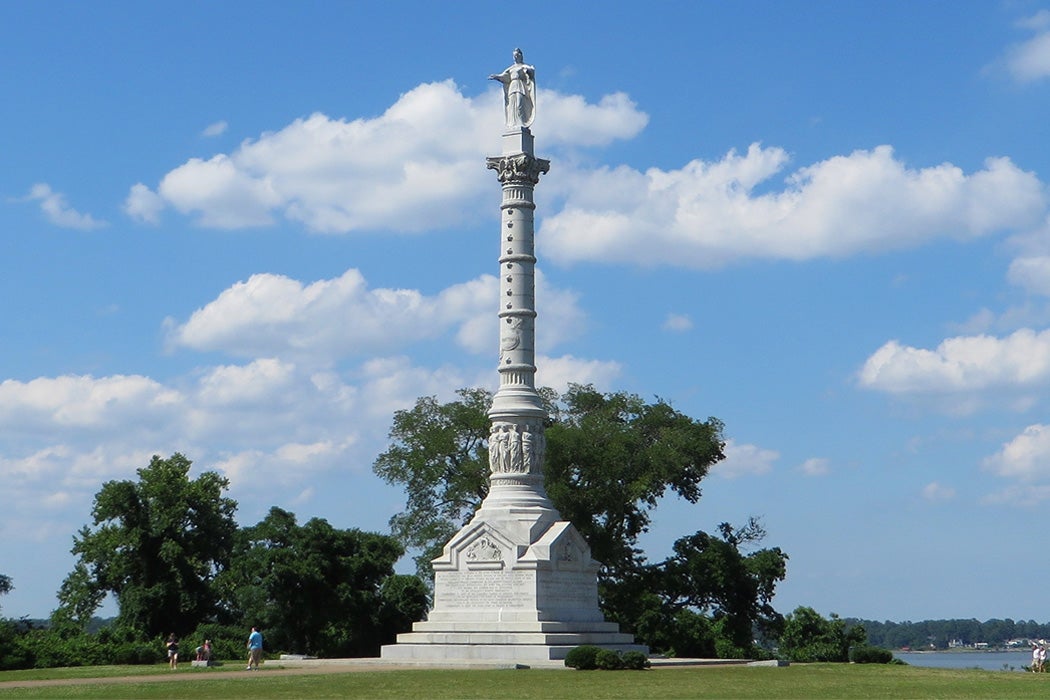The founding of the Colonial National Monument (CNM) in 1931 is a case study of the way African Americans were intentionally written out of American history until well into the twentieth century. The CNM was one of the first national historic preservation projects initiated by the National Park Service. Located on Virginia’s Peninsula, the CNM united the “Historic Triangle” of the Revolutionary War site of Yorktown, Williamsburg (capital of Virginia from 1699-1780), and Jamestown (the first permanent English settlement in North America, 1607) via a connecting scenic parkway. The impetus for the monument was the 150th anniversary of the Battle of Yorktown (1781).
The elaborate four-day festivities marking the opening of the CNM included notables like General John Pershing, France’s Marshal Pétain, the Secretary of the Interior, and New York governor Franklin Delano Roosevelt, a year before his election to the presidency.
Speakers and promoters at the pageant, historian Jeffrey Kosiorek writes, celebrated the “ideals conceived at Jamestown, developed at Williamsburg, and birthed at Yorktown.” FDR’s speech called the resulting United States “a new concept of liberty for the human race.” The festivities, however, were racially segregated.
As Kosiorek details, the CNM erased the history of blacks in the colonial era, a history dating at least to 1619. Two and a half centuries of American slavery went unmentioned. (Native Americans hardly fared better: white re-enactors in redface portrayed them because festival organizers said contemporary Native Americans in the region had “a very large mixture of Negro blood” and were “people of low morals.”)
Removing blacks and Indians from the colonial and Revolutionary past, indeed from the American past, presented more clearly the racial composition of the imagined national identity offered as the sesquicentennial and CNM. It also avoided confronting the contradictions between the vaunted ideals America brought forth and the country’s historic treatment of these groups.
This revision of the American past as a whites-only affair was conscious decision on the part of the organizers. These federal, state, and local officials and citizens crafted a racial narrative informed by the restrictive immigration policies of the 1920s: American history was to be culmination of Northern European Protestant destiny.
The forces that brought together the CNM pointedly ignored the remains of the Civil War in the area. (The Peninsula Campaign of 1862 saw more than 52,000 casualties.) What Kosiorek calls the “emancipationist memory” of that conflict, which “highlighted the end of slavery and equality of blacks as the chief meaning of the conflict” was officially suppressed. The “new birth of freedom” declared by Abraham Lincoln at Gettysburg wasn’t on the monument’s agenda.
Meanwhile, the NPS decided to route Colonial Parkway through a black neighborhood that traced its history to Emancipation. This meant condemning the property and destroying homes, “something they carefully avoided doing to houses in and around Williamsburg.”
Once a Week
Because of the spread-out nature of the CNM and paucity of park rangers, pamphlets were the main media of information at the sites in the historic triangle. These, Kosiorek writes, made no mention of slavery until they were revised in 1946.
Nevertheless, African Americans living on the Peninsula, more than half the area’s population, “long had their own set of commemorations, highlighting their membership in the nation.” These culminated on the annual May 13th celebration of Emancipation Day, when a procession would lead to the black burial ground “outside the walls of the national cemetery” at Yorktown—just a “few miles from where the first Africans landed in the British mainland colonies.”







